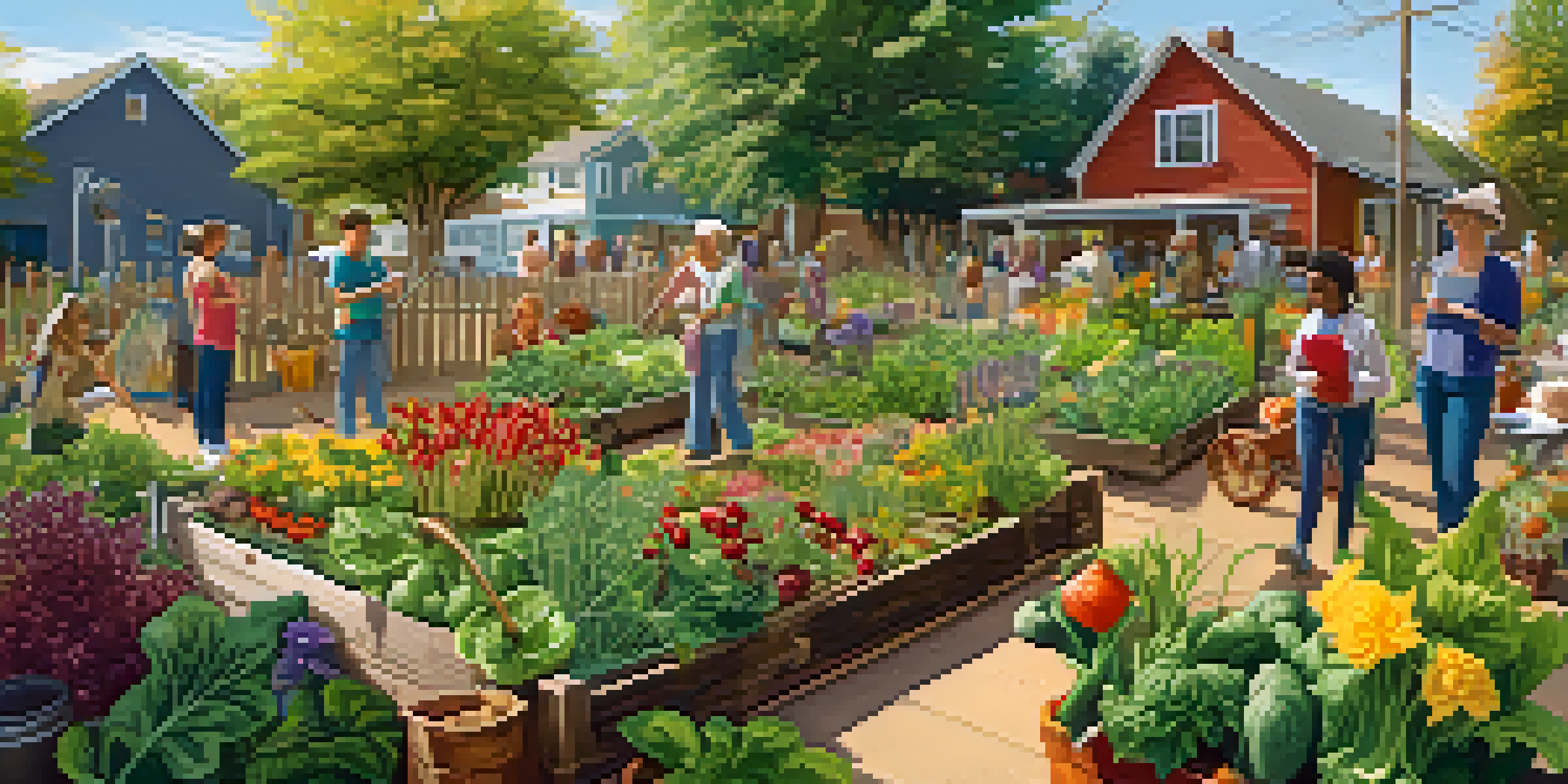Building Resilience Through Sustainable Community Practices

Understanding Community Resilience and Sustainability
Community resilience refers to the ability of a community to bounce back from challenges such as natural disasters or economic downturns. It's about how people come together to support one another and rebuild effectively. Sustainability, on the other hand, focuses on practices that meet present needs without compromising future generations' ability to meet theirs.
Sustainability is not just about the environment; it's about the people who inhabit it.
The intersection of these two concepts lies in the idea that sustainable practices can enhance a community's resilience. For example, communities that engage in local farming not only provide food security but also create bonds among residents. This interconnectedness is crucial when facing crises, as it fosters collaboration and mutual support.
By understanding and implementing sustainable practices, communities can better prepare for and recover from adversities. It's like planting seeds today for a stronger tomorrow, ensuring that everyone has a role to play in cultivating resilience.
The Role of Local Food Systems in Resilience
Local food systems are a prime example of how sustainability can bolster community resilience. When communities prioritize sourcing food locally, they reduce reliance on outside resources, which can be disrupted during crises. This self-sufficiency not only supports local economies but also fosters a sense of pride and ownership among residents.

Imagine a community where farmers and residents collaborate to establish a farmers' market. This not only provides access to fresh produce but also creates a gathering space for neighbors to connect. Such interactions strengthen social ties, which are essential in times of need.
Community Resilience Through Unity
Communities can enhance resilience by fostering social ties and collaboration, especially during challenging times.
Additionally, local food systems encourage diverse agricultural practices, which can enhance food security. By planting a variety of crops, communities can mitigate the risk of total crop failure due to pests or climate change, ensuring that they have food sources even in tough times.
Community Gardens: Cultivating Connections and Skills
Community gardens are a fantastic way to foster resilience through sustainability. These shared spaces allow residents to cultivate their own food, learn new skills, and connect with their neighbors. The process of tending to a garden together can also build friendships and a sense of belonging.
The greatest danger in times of turbulence is not the turbulence; it is to act with yesterday's logic.
For instance, consider a neighborhood that transforms a vacant lot into a vibrant garden. Residents come together to plant vegetables and flowers, sharing gardening tips and recipes as they work. This not only beautifies the area but also creates a supportive network that can be relied on during challenging times.
Moreover, community gardens can serve as educational hubs, teaching participants about sustainable practices like composting and organic farming. Such knowledge empowers individuals and equips them with the tools to contribute to resilience efforts in their own homes and beyond.
Renewable Energy Initiatives for Community Empowerment
Investing in renewable energy initiatives can significantly enhance a community's resilience. By harnessing sources like solar or wind power, communities can reduce their dependence on external energy supplies. This self-sufficiency not only lowers costs but also shields residents from energy price volatility.
Picture a town that establishes a community solar farm. Residents can invest in panels and benefit from lower energy bills while contributing to a sustainable future. Additionally, this collective effort can unite residents around a common goal, fostering teamwork and resilience.
Local Food Systems Boost Sustainability
Prioritizing local food sources not only strengthens economies but also builds pride and interconnectedness among residents.
Furthermore, renewable energy projects often create local jobs, boosting the economy and providing skill development opportunities. This combination of economic growth and environmental stewardship lays a solid foundation for communities to thrive, even in uncertain times.
Waste Reduction Practices That Strengthen Communities
Waste reduction practices play a crucial role in building community resilience. By minimizing waste, communities can conserve resources and reduce their environmental footprint. This proactive approach not only benefits the planet but also encourages creativity and collaboration among residents.
For example, a neighborhood might organize a monthly clean-up event, where residents come together to collect litter and recycle materials. This collective effort not only beautifies the area but also cultivates a sense of responsibility and pride. As people work together, they forge deeper connections that can be relied upon during emergencies.
Additionally, educational workshops on recycling and composting can empower residents to adopt sustainable habits in their daily lives. When individuals understand the impact of their choices, they are more likely to contribute to a resilient community that prioritizes sustainability.
Engaging Youth in Sustainable Community Practices
Engaging youth in sustainable community practices is vital for fostering long-term resilience. When young people are involved in initiatives like community gardens or recycling programs, they develop a sense of ownership and responsibility toward their environment. This engagement ensures that sustainability becomes a shared value across generations.
Consider a school that partners with local organizations to create educational programs focused on sustainability. Students learn about environmental issues while actively participating in solutions. This hands-on experience not only educates them but also inspires them to advocate for positive change in their communities.
Engaging Youth for Lasting Impact
Involving young people in sustainability initiatives cultivates a sense of responsibility and leadership that ensures future community resilience.
Moreover, when youth are given leadership roles in these initiatives, it builds their confidence and skills. Empowering the next generation to take charge of sustainability efforts creates a cycle of resilience that benefits everyone, as they carry these lessons into adulthood.
Collaborative Leadership for a Resilient Future
Collaborative leadership is essential for fostering resilience through sustainable practices. When community leaders work together, they can share resources, ideas, and strategies that enhance the overall effectiveness of resilience initiatives. This teamwork creates a united front, making it easier to tackle challenges as they arise.
For instance, a coalition of local businesses, government officials, and residents might come together to create a sustainability plan. By pooling their knowledge and expertise, they can develop comprehensive solutions that address the specific needs of the community. This collective effort not only leads to better outcomes but also builds trust among stakeholders.

Furthermore, inclusive leadership ensures that all voices are heard in the decision-making process. By engaging diverse perspectives, communities can create more equitable and effective resilience strategies that benefit everyone. This collaborative spirit strengthens the social fabric, making it easier to adapt to future challenges.
Measuring Success: The Impact of Sustainable Practices
Measuring the success of sustainable community practices is crucial for understanding their impact on resilience. By tracking progress through metrics such as community engagement, resource usage, and economic growth, communities can assess what works and what needs improvement. This data-driven approach allows for continuous refinement and adaptation.
For example, a community might conduct surveys to gauge resident satisfaction with local food systems or energy initiatives. Analyzing this feedback can provide valuable insights into areas for enhancement. When residents see their input valued, it reinforces their commitment to the community's sustainability efforts.
Additionally, success stories can inspire other communities to adopt similar practices. Sharing these achievements not only highlights the benefits of sustainability but also fosters a sense of hope and motivation. After all, when we see tangible results, we're more likely to believe in the power of collective action.